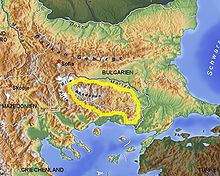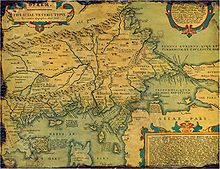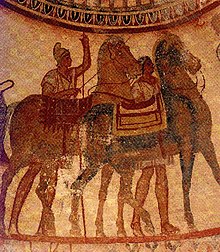Thrace: Difference between revisions
Thracian2005 (talk | contribs) No edit summary |
Thracian2005 (talk | contribs) No edit summary |
||
| Line 34: | Line 34: | ||
The Thracians did not describe themselves as such and ''Thrace'' and ''Thracians'' are simply the names given them by the Greeks.<ref>The [[Cambridge Ancient History]], Volume 3, Part 2: The Assyrian and Babylonian Empires and Other States of the Near East, from the Eighth to the Sixth Centuries BC by John Boardman, I. E. S. Edwards, E. Sollberger, and N. G. L. Hammond ,ISBN 0521227178,1992,page 597: "We have no way of knowing what the Thracians called themselves and if indeed they had a common name...Thus the name of Thracians and that of their country were given by the Greeks to a group of tribes occupying the territory..."</ref> |
The Thracians did not describe themselves as such and ''Thrace'' and ''Thracians'' are simply the names given them by the Greeks.<ref>The [[Cambridge Ancient History]], Volume 3, Part 2: The Assyrian and Babylonian Empires and Other States of the Near East, from the Eighth to the Sixth Centuries BC by John Boardman, I. E. S. Edwards, E. Sollberger, and N. G. L. Hammond ,ISBN 0521227178,1992,page 597: "We have no way of knowing what the Thracians called themselves and if indeed they had a common name...Thus the name of Thracians and that of their country were given by the Greeks to a group of tribes occupying the territory..."</ref> |
||
Divided into separate tribes, the Thracians did not manage to form a lasting political organization until the [[Odrysian|Odrysian state]] was founded in the 4th century BC. Like [[Illyrians]], the mountainous regions were home to various wild, untamed and courageous Thracian tribes, while the plains peoples were purportedly more peaceable. |
Divided into separate tribes, the Thracians did not manage to form a lasting political organization until the [[Odrysian|Odrysian state]] was founded in the 4th century BC. Like [[Illyrians]], the mountainous regions were home to various wild, untamed and courageous Thracian tribes, while the plains peoples were purportedly more peaceable. Although recent funeral mounds in Bulgaria suggest that Thracian kings did rule regions of Thrace with distinct Thracian national identity. |
||
During this period, a subculture of [[celibacy|celibate]] [[ascetics]] called the [[Ctistae]] lived in Thrace, where they served as philosophers, priests and prophets. |
During this period, a subculture of [[celibacy|celibate]] [[ascetics]] called the [[Ctistae]] lived in Thrace, where they served as philosophers, priests and prophets. |
||
Revision as of 05:22, 23 March 2010





Thrace ([Тракия, Trakiya] Error: {{Lang-xx}}: text has italic markup (help), [Θράκη, Thráki] Error: {{Lang-xx}}: text has italic markup (help), Turkish: Trakya) is a historical and geographic area in southeast Europe. As a geographical concept, Thrace designates a region bounded by the Balkan Mountains on the north, Rhodope Mountains and the Aegean Sea on the south, and by the Black Sea and the Sea of Marmara on the east.[1][2] The region comprises areas in southeastern Bulgaria (Northern Thrace), northeastern Greece (Western Thrace), and the whole of the European part of Turkey (Eastern Thrace). In Turkey, it is also called Rumeli. The name comes from the Thracians, an ancient Indo-European people inhabiting Central, Eastern and Southeastern Europe.
Geography
Borders
The historical boundaries of Thrace have varied. Noteworthy is the fact that, at an early date, the ancient Greeks employed the term "Thrace" to refer to all of the territory which lay north of Greece (of Thessaly) inhabited by the Thracians[3], a region which "had no definite boundaries" and to which other regions (like Macedonia and even Scythia) were added.[4] In one ancient Greek source, the very Earth is divided into "Asia, Libya, Europa and Thracia"[5]. As the knowledge of world geography of the Greeks broadened, the term came to be more restricted in its application: Thrace designated the lands bordered by the Danube on the north, by the Euxine Sea (Black Sea) on the east, by northern Macedonia in the south and by the Illyrian lands (i.e. Illyria) to the west.[6] This largely coincided with the Thracian Odrysian kingdom, whose borders varied in time. During this time, specifically after the Macedonian conquest, the region's old border with Macedonia was shifted from the Struma River to the Mesta River.[7][8] This usage lasted until the Roman conquest. Henceforth, (classical) Thrace referred only to the tract of land largely covering the same extent of space as the modern geographical region. In its early period, the Roman province of Thrace was of this extent, but after the administrative reforms of the late 3rd century, Thracia's much reduced territory became of the six small provinces which constituted the Diocese of Thrace. The medieval Byzantine theme of Thrace contained only what today is Eastern Thrace.
Cities of Thrace
The largest cities of Thrace are: Istanbul (European side), Plovdiv, Burgas, Edirne.
Demographics and Religion
Most of the Bulgarian and Greek population are Christians, while most of the Turkish inhabitants of Thrace are Muslims.
Thrace in ancient Greek mythology
Ancient Greek mythology provides them with a mythical ancestor, named Thrax, son of the war-god Ares, who was said to reside in Thrace. The Thracians appear in Homer's Iliad as Trojan allies, led by Acamas and Peiros. Later in the Iliad, another Thracian king makes an appearance, named Rhesus. Cisseus, father-in-law to the Trojan elder Antenor, is also given as a Thracian king. Homeric Thrace was vaguely defined, and stretched from the River Axios in the west to the Hellespont and Black Sea in the east. The Catalogue of Ships mentions three separate contingents from Thrace: Thracians led by Acamas and Peiros, from Aenus; Cicones led by Euphemus, from southern Thrace, near Ismaros; and from the city of Sestus, on the Thracian (northern) side of the Hellespont, which formed part of the contingent led by Asius. Greek mythology is replete with Thracian kings, including Diomedes, Tereus, Lycurgus, Phineus, Tegyrius, Eumolpus, Polymnestor, Poltys, and Oeagrus (father of Orpheus). In addition to the tribe that Homer calls Thracians, ancient Thrace was home to numerous other tribes, such as the Edones, Bisaltae, Cicones, and Bistones.
History
Ancient history

The indigenous population of Thrace was a people called the Thracians, divided into numerous tribal groups. Thracian troops were known to accompany neighboring ruler Alexander the Great when he crossed the Hellespont which abuts Thrace, and took on the Persian Empire of the day.
The Thracians did not describe themselves as such and Thrace and Thracians are simply the names given them by the Greeks.[9]
Divided into separate tribes, the Thracians did not manage to form a lasting political organization until the Odrysian state was founded in the 4th century BC. Like Illyrians, the mountainous regions were home to various wild, untamed and courageous Thracian tribes, while the plains peoples were purportedly more peaceable. Although recent funeral mounds in Bulgaria suggest that Thracian kings did rule regions of Thrace with distinct Thracian national identity.
During this period, a subculture of celibate ascetics called the Ctistae lived in Thrace, where they served as philosophers, priests and prophets.
Medieval history
By the mid 5th century, as the Roman Empire began to crumble, Thracia fell from the authority of Rome and into the hands of Germanic tribal rulers. With the fall of Rome, Thracia turned into a battleground territory for the better part of the next 1,000 years. The eastern successor of the Roman Empire in the Balkans, the Byzantine Empire, retained control over Thrace until the beginning of the 9th century when most of the region was incorporated into Bulgaria. Byzantium regained Thrace in 972 only to lose it again to the Bulgarians at the end of the 12th century. Throughout the 13th century and the first half of the 14th century, the region oscillated between Bulgaria and the Byzantine Empire. In 1265 the area suffered a Mongol raid from Golden Horde, led by Nogai Khan. In 1352, the Ottoman Turks conducted their first incursion into the region subduing it completely within a matter of two decades and occupying it for five centuries.
Modern history

With the Congress of Berlin in 1878, Northern Thrace was incorporated into the semi-autonomous Ottoman province of Eastern Rumelia, which united with Bulgaria in 1885. The rest of Thrace was divided between Bulgaria, Greece and Turkey at the beginning of the 20th century, following the Balkan Wars, World War I and the Greco-Turkish War. Today Thracian is a strong regional identity in Greece, Turkey, Bulgaria and other neighbouring countries.
Famous Thracians and people from Thrace
- In Ancient Greek mythology, Orpheus was the chief representative of the art of song and playing the lyre.
- Democritus was a Greek philosopher and mathematician from Abdera, Thrace (c. 460–370 BC.) His main contribution is the atomic theory, the belief that all matter is made up of various imperishable indivisible elements which he called atoms.
- Herodicus was a Greek physician of the fifth century BC who is considered the founder of sports medicine. He is believed to have been one of Hippocrates' tutors.
- Protagoras was a Greek philosopher from Abdera, Thrace (c. 490–420 BC.) An expert in rhetorics and subjects connected to virtue and political life, often regarded as the first sophist. He is known primarily for three claims (1) that man is the measure of all things, often interpreted as a sort of moral relativism, (2) that he could make the "worse (or weaker) argument appear the better (or stronger)" (see Sophism) and (3) that one could not tell if the gods existed or not (see Agnosticism).
- Spartacus was a Thracian auxiliary soldier in the Roman army who deserted but was captured and then enslaved by the Romans. He led a large slave uprising in what is now Italy in 73–71 BC. His army of escaped gladiators and slaves defeated several Roman legions in what is known as the Third Servile War.
- Maximinus Thrax, Roman emperor (AD 235–238), was born in Thrace or Moesia to a Gothic father and an Alanic mother.
- Ataturk ( 1881 -1938), bas born in Thesallaniko in Thrace, founder of the Modern Republic of Turkey
See also
- Music of Thrace
- Dacia
- Moesia
- Macedon
- Paionia
- Dardania
- The Destruction of Thracian Bulgarians in 1913
- Bulgarisation
- Expulsion of Jews from Thessalaniko
- 1989 expulsion of Turks from Bulgaria
- Turkish Republic of Thrace
- Turks of Western Thrace
- 1934 Thrace Pogroms
- Kara Thrace, a fictional character from the series Battlestar Galactica
- Spartacus:Blood and Sand
Notes
- ^ Glen Warren Bowersock, Peter Robert Lamont Brown, Oleg Grabar, Late antiquity, Princeton Univ. Press, 1999, p.726 [1]
- ^ Thomas Swinburne Carr, The history and geography of Greece, p.56 [2]
- ^ Thomas Swinburne Carr, The history and geography of Greece, p.56 [3]
- ^ Sir William Smith, Dictionary of Greek and Roman geography, London, 1857, p. 1176 [4]
- ^ Sir William Smith, Dictionary of Greek and Roman geography, London, 1857, p. 1176 [5]
- ^ Sir William Smith, Dictionary of Greek and Roman geography, London, 1857, p. 1176 [6]
- ^ Johann Joachim Eschenburg, Nathan Welby Fiske, Manual of classical literature, p. 20. [7]
- ^ Alexander Adam, A summary of geography and history, both ancient and modern, p.344 (full view)
- ^ The Cambridge Ancient History, Volume 3, Part 2: The Assyrian and Babylonian Empires and Other States of the Near East, from the Eighth to the Sixth Centuries BC by John Boardman, I. E. S. Edwards, E. Sollberger, and N. G. L. Hammond ,ISBN 0521227178,1992,page 597: "We have no way of knowing what the Thracians called themselves and if indeed they had a common name...Thus the name of Thracians and that of their country were given by the Greeks to a group of tribes occupying the territory..."
References
- Hoddinott, R.F., The Thracians, 1981.
- Ilieva, Sonya, Thracology, 2001
External links
- Ethnological Museum of Thrace, comprehensive website on Thracian history and culture.
- Bulgaria's Thracian Heritage. including images of the comprehensive art collection of Thracian gold found on the territory of contemporary Bulgaria.
- Information on Ancient Thrace
- Articles needing cleanup from May 2007
- Cleanup tagged articles without a reason field from May 2007
- Wikipedia pages needing cleanup from May 2007
- Thrace
- History of Turkey
- Geography of Turkey
- Ancient Roman provinces
- History of Bulgaria
- History of Greece
- Thracians
- Bulgarian historical regions
- Geography of Greece
- Divided regions
